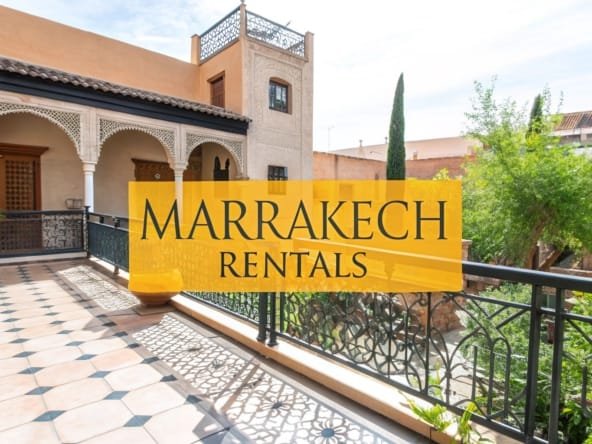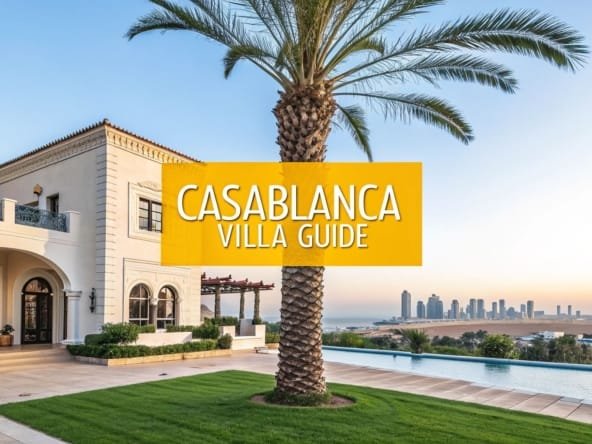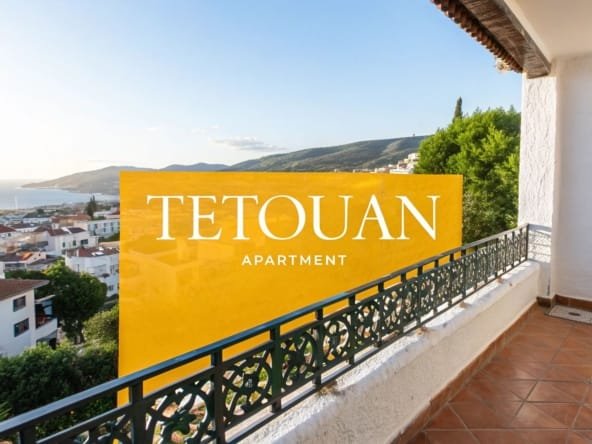While Casablanca pulses with a distinctly modern energy, its Art Deco skyline telling a story of 20th-century ambition, another world waits just behind the simple, unassuming doors of its Old Medina.
Unlike the well-trodden paths of Marrakech or Fes, finding an authentic riad in Casablanca is a rare treat. This scarcity presents a unique chance to own a genuine piece of Moroccan heritage. These traditional homes, designed around tranquil central courtyards, are more than just buildings; they're an escape into a quieter, more historic Morocco.
Unveiling Casablanca's Hidden Architectural Soul
As Morocco's economic powerhouse, Casablanca is a sprawling metropolis defined by wide boulevards and contemporary architecture. First-time visitors, perhaps expecting the cinematic charm of old-world Morocco, often find themselves in a fast-paced, modern city instead. Casablanca doesn't give up its secrets easily like Marrakech or Chefchaouen; its beauty is more subtle, rewarding those willing to look a little closer.
This guide is your invitation to peel back that modern layer. We'll venture beyond the concrete and into the quiet, winding alleyways of the Old Medina, where the city’s last few riads stand as proud testaments to a bygone era. These architectural gems offer a stunning contrast to the city's commercial hum, providing a sanctuary of peace, privacy, and incredible traditional craftsmanship.
What to Expect on This Journey
Diving into the world of Casablanca's riads is about more than just a property hunt. It’s an immersion into a unique lifestyle and, for the savvy investor, a promising opportunity. We've designed this guide to be a complete overview for everyone, from curious cultural enthusiasts to serious prospective buyers.
- Architectural Identity: You'll learn to spot the essential features of a true riad, from the soul of the home—the central courtyard or wast ad-dar—to the intricate zellij tilework where every pattern tells a story.
- Navigating the Market: We'll give you practical, on-the-ground insights into the local property market. This includes current price trends, the legal steps for foreign buyers, and the key differences between buying a fully restored riad versus one ready for renovation.
- Prime Locations: We’ll pinpoint the historic quarters, like the Old Medina and the Habous, where these rare properties are still found.
Owning a riad in Casablanca means becoming a custodian of history. It's also a significant financial commitment, from the initial purchase to potential restoration work, all of which is shaped by the general cost of living in Morocco. Our goal is to arm you with the knowledge you need to turn a historic relic into your own private haven or a profitable venture.
The Architectural Heart of a Riad
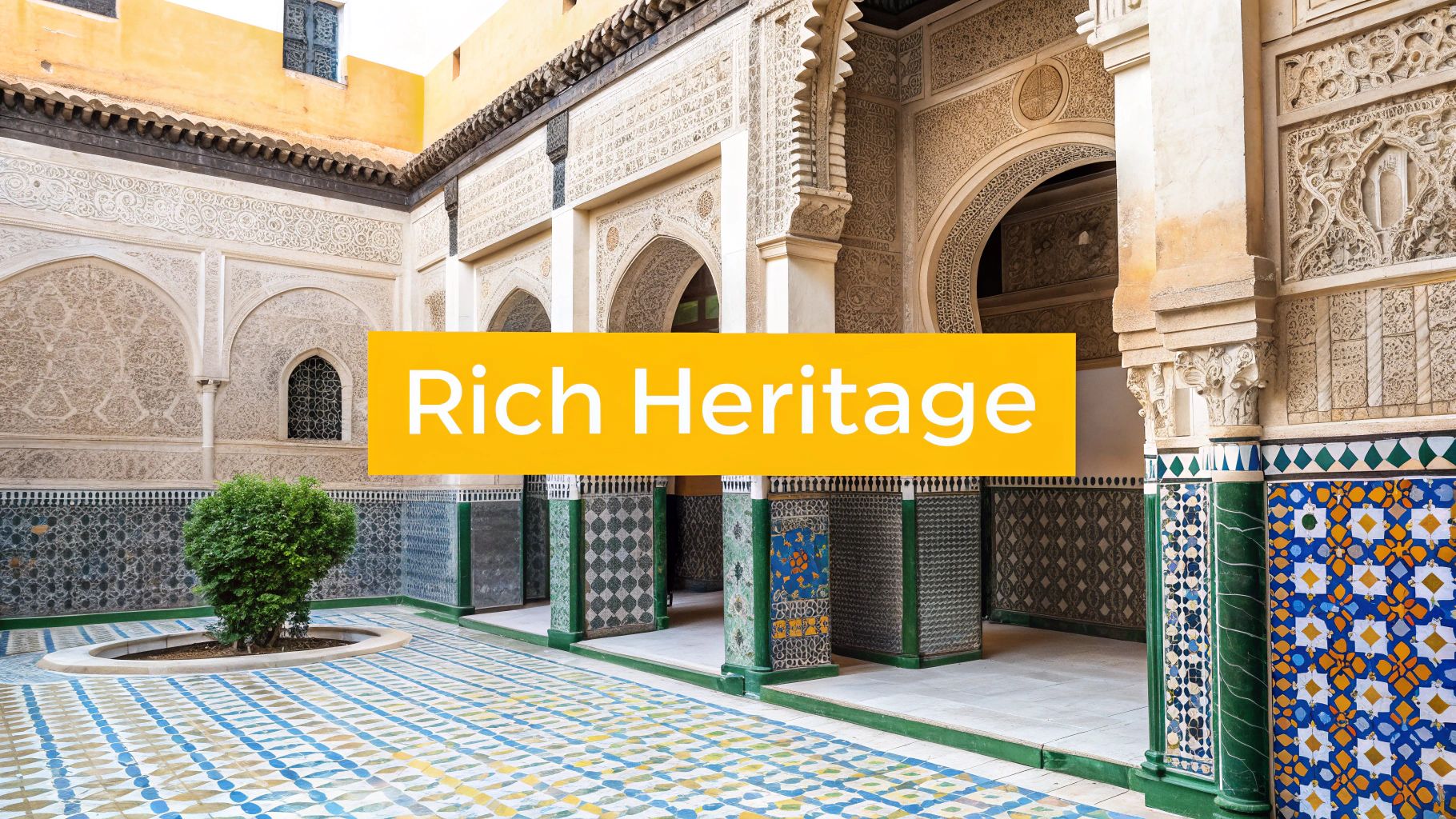
Walking into one of the traditional riads in Casablanca feels like stepping into another world. From the outside, you’re often looking at a plain, almost windowless wall facing a noisy medina alley. That’s not by accident. This modest facade is a core part of the design, born from Islamic principles that hold privacy and the family sanctuary in high regard. There’s no grand entrance, just a simple, solid door.
This unassuming exterior is exactly what makes the moment you cross the threshold so powerful. Suddenly, the chaos of the city melts away, replaced by an overwhelming sense of peace. The entire structure is designed to pull your focus inward, away from the public street and into the private heart of the home.
The Central Courtyard: An Open-Air Oasis
At the very core of every riad is its central courtyard, or wast ad-dar in Moroccan Arabic. This isn't just a garden—it’s the building’s lungs, providing light, air, and life to the entire home. Think of it as a personal town square for the family, completely hidden from prying eyes.
Usually square or rectangular, the courtyard almost always has a fountain at its centre, its gentle splashing creating a constant, calming soundtrack. You’ll often find fragrant orange or lemon trees, lush plants, and quiet seating nooks arranged around it. All the ground-floor rooms open directly onto this courtyard, blurring the line between inside and out. It’s a brilliant piece of passive climate control, too, naturally keeping the home cool during the intense Moroccan summers.
The inward-facing design of a riad is a direct reflection of cultural values. It prioritises the family unit and communal living within a private, secure environment, turning its back on the chaos of the street to create an internal paradise.
Casablanca’s architectural story is fascinating. During the French Protectorate, the city saw a boom in urban planning that stood in stark contrast to the historic medina, the traditional home of the riad. As the new city grew, the riads in the old quarter remained bastions of history, defined by their courtyards and incredible craftsmanship. For anyone interested in the city’s unique development, you can find more insights about Casablanca's architecture on Wikipedia.
Signature Elements of Riad Design
Beyond the courtyard, a few key artistic traditions give a riad its soul. These aren't just decorative flourishes; they represent centuries of artisanal skill passed down from one generation to the next. Knowing what to look for really deepens your appreciation for these homes.
- Zellij Tilework: This is probably the most recognisable feature. Zellij is the art of hand-cutting tiny geometric tiles and arranging them into breathtakingly complex mosaics. You’ll see it on fountains, floors, and walls, each pattern a masterpiece of mathematical precision and artistic vision.
- Gebs Plasterwork: Look up. That intricate, lace-like carving on the walls and archways is gebs. It's a special type of gypsum plaster that artisans meticulously hand-carve while it's still wet, creating stunning floral patterns and calligraphic inscriptions.
- Tadelakt Surfaces: If you notice a smooth, seamless, and subtly glossy finish on a bathroom wall or column, you’re looking at tadelakt. This traditional waterproof lime plaster is painstakingly polished with river stones and sealed with black soap, resulting in a surface that’s both beautiful and incredibly durable.
- Carved Cedarwood: The rich, earthy scent you often notice is cedarwood. It's used for ceilings, doors, and the latticed window screens known as moucharabieh. The elaborate carvings add a layer of warmth and texture that you just can't replicate.
All these elements come together to create a full sensory experience. The sound of running water, the smell of citrus blossoms and cedar, the cool touch of tile under your feet—it all contributes to the riad's unique atmosphere of serene escape. This is the architectural language that gives the riads in Casablanca their timeless appeal.
How to Navigate the Riad Real Estate Market
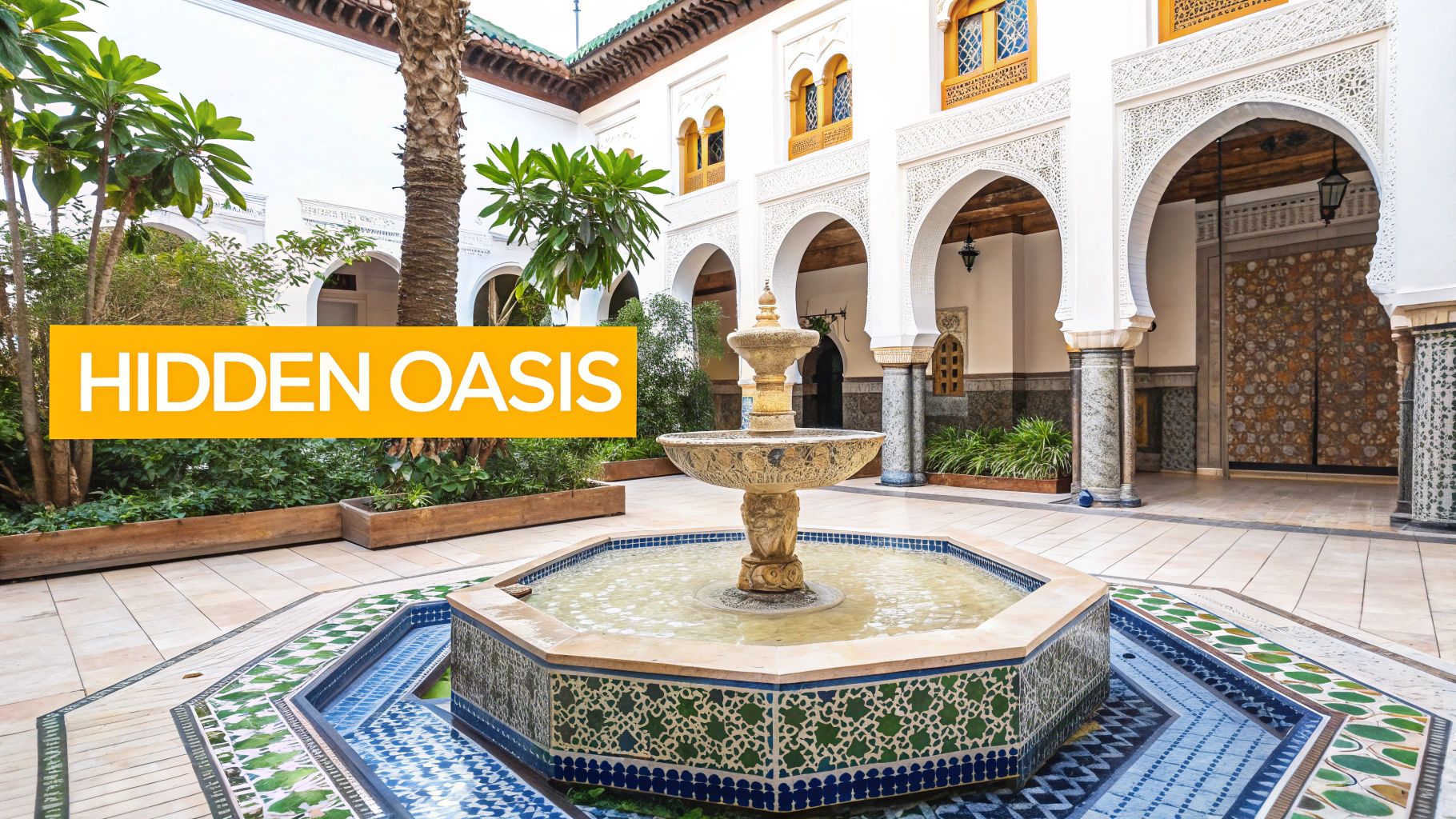
Stepping into the market for riads in Casablanca is an entirely different world compared to buying a modern apartment or villa. It’s a niche driven by a potent mix of heritage, tourism, and a fundamentally limited supply. Each riad is a piece of history, and that scarcity is precisely what makes them so valuable. Getting your head around these unique dynamics is the first real step towards making a smart investment.
The demand for these historic homes typically comes from two distinct camps. On one side, you have international buyers hunting for a one-of-a-kind holiday escape or a boutique hotel project. On the other, you have Moroccans—both local and expatriate—who want to own a tangible piece of their cultural heritage. This creates a fascinating market where emotional connection and commercial potential are equally powerful forces.
This isn't just a local trend; it’s part of a much larger national movement to breathe new life into Morocco's historic medinas. A 2006 report, for example, found that thirty-three grand homes across the country had been privately transformed into high-end guesthouses. This shows just how prized these traditional dwellings have become as economic assets. You can dig deeper into this heritage tourism trend in this detailed study.
Restored Gem or Renovation Project
One of the biggest forks in the road you'll encounter is deciding between a fully restored riad and a renovation project. It’s a bit like choosing between a finished painting and a blank canvas—each path offers its own set of rewards and challenges.
A turnkey, restored riad gives you instant gratification. You can move in or start renting it out almost immediately, skipping the months of dust, decisions, and delays that come with a major building project. It’s the perfect route for buyers who value convenience and need to stick to a firm budget.
But a riad in need of restoration? That's your chance to create something truly personal. You get to infuse the space with your own vision, blending modern comforts seamlessly with timeless Moroccan aesthetics. The initial purchase price is often much lower, but don’t be fooled—the total investment in time, money, and sheer emotional energy can be significant. For a wider perspective on property in the city, have a look at our guide to real estate in Casablanca.
Key Takeaway: Your choice between a finished property and a project depends entirely on your appetite for risk, your budget’s flexibility, and how badly you want a custom-finished home. A renovation can deliver incredible personal satisfaction and potentially higher returns, but it demands meticulous planning and a rock-solid local team.
Demystifying the Legal Landscape for Foreign Buyers
Getting the legal side right is without a doubt the most crucial part of buying a riad. The good news for foreign nationals is that the process is quite straightforward, but it demands sharp attention to detail and the right professional guidance.
The absolute cornerstone of any secure property purchase here is the title deed. Understanding the two main types is vital to protecting your investment.
- Titre Foncier: This is the gold standard of property ownership in Morocco. It's a modern, definitive title registered with the national land registry (ANCFCC). A titre foncier means the property's boundaries and ownership are clear, indisputable, and secure for transfer.
- Melkia: This is a more traditional, un-registered deed. Its legitimacy is often based on historical precedent and witness testimony rather than a central database. While legally recognised, melkia titles can sometimes be ambiguous, leaving them open to ownership disputes. It's possible to convert a melkia to a titre foncier, but be prepared for a potentially long and expensive legal journey.
The Role of the Notary
In Morocco, the notaire (notary) is a neutral, state-appointed legal expert who is central to every property transaction. Their role goes far beyond just witnessing a signature. The notaire is responsible for the due diligence on the title, drafting the final deed of sale (acte de vente), making sure all taxes are settled, and officially registering your ownership.
While the notaire ensures the transaction is legally compliant from the state’s perspective, I always recommend hiring your own independent lawyer as well. Your lawyer works for you and only you. They will represent your specific interests, review every contract with a fine-tooth comb, and provide an essential extra layer of security. This dual professional support ensures your journey into owning one of Casablanca's beautiful riads is not just exciting, but legally ironclad.
Finding Riads in Casablanca's Historic Quarters
Unlike Marrakech or Fes, where historic riads seem to be around every corner, finding one in Casablanca requires a much more targeted search. Because of the city's rapid 20th-century expansion, these architectural gems are nestled away in just a couple of specific pockets. Knowing exactly where to look is the most important first step.
Your search will almost certainly take you to one of two places: the ancient, sprawling Old Medina or the more recently established Habous Quarter. These neighbourhoods are the historic soul of an otherwise very modern city, and it's within their walls that Casablanca's traditional homes are hiding. Each area offers a completely different feel for anyone looking to live or invest there.
Sometimes, the most stunning riads are hidden behind unassuming doors. This is a perfect example of the ornate entryways that signal a private world of luxury and peace within.
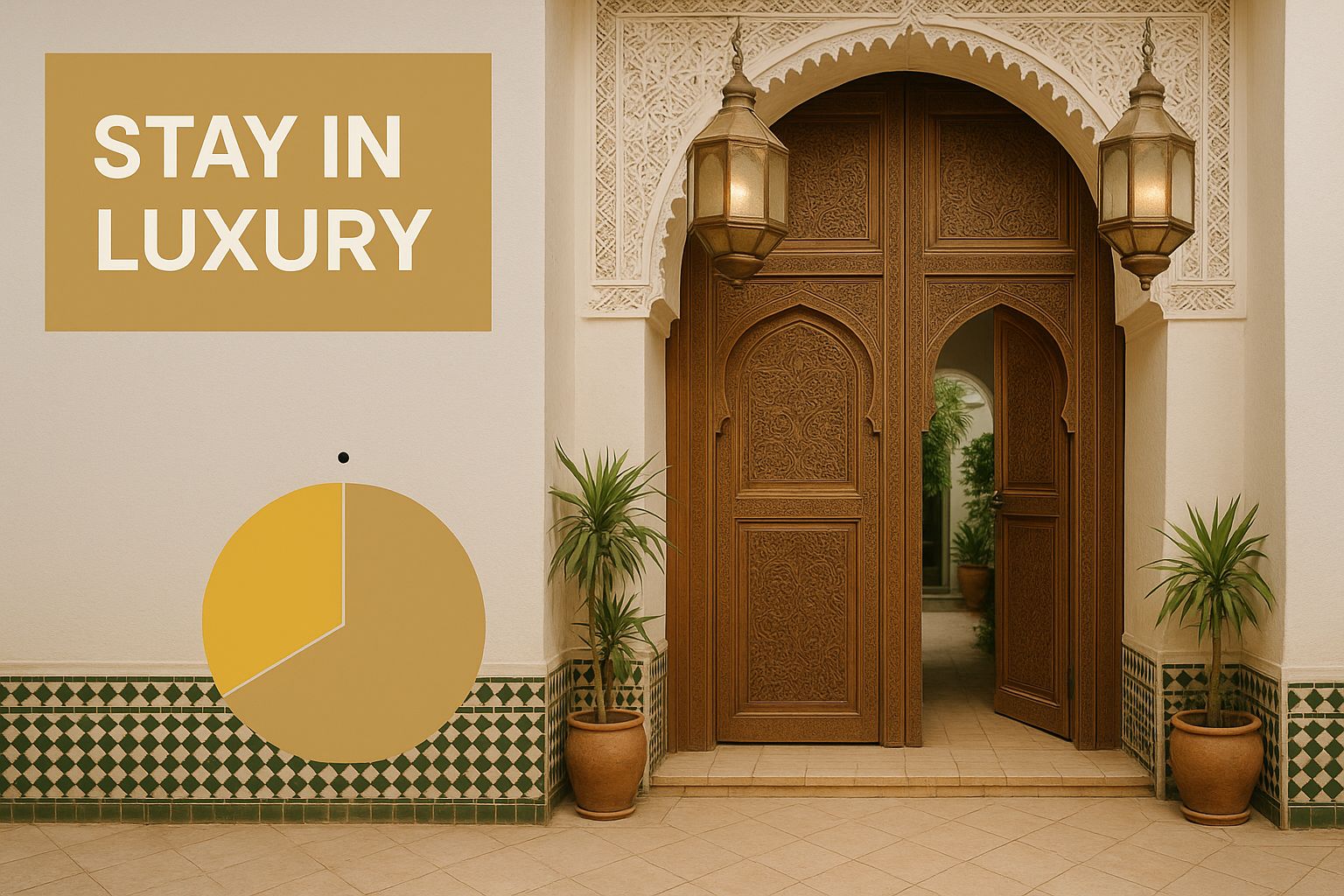
The image really captures the magic of it all—a beautiful, private entrance promising an oasis of calm just beyond the bustling street.
The Old Medina: A Labyrinth of History
The Old Medina, tucked just north of the city centre, is where Casablanca began. It’s a classic walled medina—a dense maze of tight alleyways, vibrant souks, and residential pockets that have been there for centuries. Just walking through it feels like you've been transported back in time.
The riads you'll find here are the real deal, the most authentic in the city. Many have been passed down through families for generations, which often means they're in need of serious restoration. This is where you can uncover properties with incredible original features, though they might be buried under decades of modern, functional additions.
- Atmosphere: It’s buzzing, a bit chaotic, and deeply traditional. It’s a place with a strong, close-knit community, offering a truly immersive Moroccan experience.
- Accessibility: You’ll be doing a lot of walking. The Medina is almost entirely pedestrianised, making vehicle access next to impossible. This can be a real headache when it comes to renovations.
- Investment Potential: The potential is huge for anyone wanting to create a boutique guesthouse for tourists craving that authentic vibe. The sheer scarcity of these properties keeps their value high, but you have to be realistic about renovation costs.
Finding a riad in the Old Medina feels a bit like a treasure hunt. They are almost never listed publicly. It's all about local connections, word-of-mouth, and a whole lot of patience.
The Habous Quarter: The "New Medina"
Constructed by the French in the 1920s, the Habous Quarter—often called the New Medina—presents a totally different take on Moroccan architecture. It was a planned attempt to fuse traditional Moroccan design with modern European ideas about urban living. The result is a neighbourhood that feels much more organised, with cleaner, wider streets and elegant archways.
The homes here are more accurately called dars (traditional houses) than true riads, as many lack the signature large, open-air courtyard. But they make up for it with stunning neo-Moorish details, like elaborate zellij tilework and beautifully carved plaster.
- Atmosphere: It's more polished and orderly than the Old Medina. You’ll find a pleasant mix of artisan shops, traditional markets, and quiet residential streets. It feels both historic and thoughtfully designed.
- Accessibility: Much, much better. While some lanes are for pedestrians only, many parts are accessible by car, which makes life (and renovations) a lot simpler.
- Investment Potential: Very strong, for both residential living and commercial projects. Its picture-perfect setting and easy access make it popular with locals and tourists alike, ensuring a steady rental demand for properties that have been well looked after.
Casablanca Riad Neighbourhood Comparison
To help you decide, here’s a quick breakdown of what each neighbourhood offers. Think of it as a cheat sheet for finding the Casablanca that best fits your vision.
| Neighbourhood | Architectural Style | Typical Condition | Investment Potential | Atmosphere |
|---|---|---|---|---|
| Old Medina | Authentic, centuries-old Moroccan | Often requires significant restoration | High for boutique tourism; renovation budget is key | Vibrant, traditional, chaotic, immersive |
| Habous Quarter | French-planned, neo-Moorish | Generally better maintained; some modernisation needed | Strong for rentals and residential; stable demand | Orderly, picturesque, elegant, accessible |
Ultimately, the choice between the two really comes down to what you're looking for. The Old Medina offers raw, unfiltered authenticity and the satisfaction of bringing a piece of history back to life. The Habous Quarter, on the other hand, provides a more refined and accessible entry point into traditional Moroccan living.
The Art of Bringing a Riad Back to Life
Buying a historic riad is really just the first step. The true adventure begins with the restoration—the process of breathing new life into a slice of Moroccan history. This isn't your typical home renovation. It’s a delicate dance of cultural preservation, blending the building’s original soul with the comforts of modern life.
Turning a neglected riad into a breathtaking sanctuary takes patience, a clear vision, and, crucially, the right team. While the journey has its challenges, the reward is a stunning home that honours its heritage. A thoughtfully restored riad in Casablanca is not only a beautiful place to live but also a smart investment that can significantly increase in value.
Finding Your Team of Master Artisans
The success of a riad restoration comes down to the skill of local master artisans, known as ‘maalem’. These aren't just builders; they are the guardians of centuries-old techniques passed down from one generation to the next. They speak the language of traditional Moroccan architecture.
Finding the right maalem is the single most important decision you'll make. Your team will need specialists in a few core crafts:
- Tadelakt Plaster: This is the iconic waterproof lime plaster known for its smooth, polished finish. A true tadelakt maalem can craft stunning, seamless surfaces in bathrooms and kitchens or for decorative columns that are as durable as they are beautiful.
- Zellij Mosaics: The soul of a riad often lies in its intricate, hand-cut geometric tilework. A zellij master painstakingly cuts and assembles each tiny tile by hand to create the mesmerising patterns you see on fountains, floors, and walls.
- Gebs Plasterwork: The delicate, lace-like carved plaster that adorns ceilings and archways is a specialised art. It takes an incredibly steady hand to carve the elaborate floral patterns and calligraphy that give riads their unique charm.
While these artisans are the heart of the project, understanding the entire process is key. For a more detailed look at reviving a historic property, our guide on how to renovate your dream riad in Marrakesh offers practical advice that applies just as well in Casablanca.
Navigating the Inevitable Renovation Hurdles
Restoring a centuries-old building is never a straight line. By the early 1980s, Casablanca’s rapid urban expansion began to threaten its historic medina. Urban renewal plans often prioritised new development over preservation, leaving many riads to fall into disrepair or face demolition. This legacy means that many of the properties available today need serious, structural attention. You can find more on Casablanca's urban history on Assafir Al-Arabi.
Knowing what to expect can save you a lot of headaches. You'll almost certainly run into challenges with sourcing authentic materials, navigating the building permit process, and weaving modern systems into an ancient structure without causing damage.
Expert Tip: One of the trickiest parts is updating the plumbing and electricity. It’s essential to plan these systems with meticulous detail right from the start. The last thing you want is to cut into freshly laid zellij floors or perfectly finished tadelakt walls because of poor planning.
Budgeting and Timelines: The Reality Check
Let's be realistic: you need a detailed budget and a flexible timeline. A common rule of thumb is that a full, high-quality restoration can easily cost as much as the purchase price of the riad itself, sometimes even more. Always build in a contingency fund of at least 15-20% to handle the inevitable surprises, like hidden structural problems or unexpected material shortages.
When it comes to your timeline, patience is a virtue. Sourcing specific handmade tiles or waiting for the best maalem to become available can add weeks, or even months, to your project. Rushing will only compromise the craftsmanship. Think of it as a marathon, not a sprint. Embracing that mindset is the only way to achieve a result that will truly stand the test of time.
Is a Casablanca Riad a Good Investment?
So, after diving into the architecture, the renovation headaches, and the unique market pulse of Casablanca's riads, we arrive at the big question: Is buying one actually a smart move? The honest answer isn't a simple yes or no. It really comes down to weighing the potential financial upside against the very real, intangible rewards of owning a piece of Moroccan history.
Let's talk capital appreciation. Casablanca isn't Marrakech, where the riad market is well-established and, frankly, a bit saturated. Here, the sheer rarity of these properties creates a unique investment opportunity. As Casablanca continues to cement its place on the global stage, the thirst for authentic, character-filled places to stay will only grow, which could push the value of a beautifully restored riad sky-high.
Weighing the Financial and Cultural Returns
If your goal is rental income, the potential is certainly there. More and more travellers are seeking out unique cultural experiences, and a stunning riad offers something a standard hotel simply can't match. This allows you to command premium rates for a guesthouse or a luxury short-term let, leading to some very attractive rental yields if you play your cards right.
But let's be realistic about the costs. A full-blown renovation can easily cost as much as the purchase price itself, and sometimes even more. You're not just buying a property; you're signing up for a meticulous, often long-term restoration project.
Owning a riad isn't just a real estate transaction; it's an investment in culture. The true value is a blend of potential financial gain and the personal satisfaction of preserving a unique architectural legacy for future generations.
Then there's the cultural payoff, which for many is the real draw. Owning one of the few surviving riads in Casablanca makes you a guardian of its history. In a city increasingly defined by modern towers, you get the chance to protect and showcase traditional Moroccan craftsmanship. For many buyers, this is a motivation that no spreadsheet can capture.
Final Considerations for Success
Making a success of this kind of investment boils down to good preparation and solid local knowledge. It's not a straightforward path. You'll be dealing with the intricacies of Moroccan property law and the hands-on demands of a major renovation. Trying to cut corners here can turn a dream project into a financial nightmare.
To set yourself up for success, treat these final steps as non-negotiable:
- Build Your Local Team: You absolutely need a reliable crew on the ground. This means a trustworthy real estate agent, a sharp notary, and a project manager who has specific experience with historic restorations. Don't even think about starting without them.
- Do Your Homework (Then Do It Again): Never, ever rush the legal checks. Insist on seeing the titre foncier to confirm clean ownership, and always get a comprehensive structural survey done by a professional before you sign anything.
- Embrace the Journey: Understand that renovating a riad is a marathon, not a sprint. You'll need patience, a willingness to adapt, and a genuine love for the craft. These will be your greatest assets.
Ultimately, a Casablanca riad can be an incredibly rewarding investment, but only if you go in with your eyes wide open. It demands a savvy financial mind, a passion for culture, and a solid, practical plan.
Your Questions Answered: Riads in Casablanca
Diving into the world of riads in Casablanca always sparks a few key questions, especially for those new to the market. This isn't Marrakech or Fes; Casablanca plays by its own rules. Getting clear answers before you even start looking is crucial. Let's tackle some of the most common queries I hear.
Are Riads as Common in Casablanca as in Marrakech or Fes?
In a word, no. Authentic, traditional riads are a genuine rarity here. Casablanca's big boom in the 20th century saw the city embrace European architectural styles, particularly Art Deco. Because of this, true riads are almost entirely tucked away within the old, compact Medina. It's a world away from the vast, riad-filled medinas you find elsewhere.
This scarcity, however, is what makes them so special. Finding a riad in Casablanca feels like unearthing a hidden gem. The limited number of properties means each one is not just a home, but an exclusive piece of the city's original soul—a truly unique investment.
What Are the Main Legal Steps for a Foreigner Buying a Riad?
For a non-Moroccan, the buying process is straightforward but absolutely requires professional guidance to keep the transaction safe. Think of it as a clear, multi-step path designed to protect everyone involved.
Here's what the journey typically looks like:
- Signing the preliminary sales agreement: This is the compromis de vente, and it lays out all the terms of the deal.
- Paying a deposit: This is standard practice and the funds are held securely in an escrow account managed by a notary.
- Conducting thorough due diligence: This is where you verify the property title. A titre foncier (a registered, modern title) is what you want—it offers far more legal security than the traditional melkia.
- Signing the final deed: The acte de vente is signed in front of a certified notary (notaire), making it all official.
The notary is a neutral government-appointed official who handles the legalities, but I always advise clients to hire their own lawyer as well. It’s an invaluable extra layer of security.
It's important to understand the distinction: the notary ensures the transaction follows the law for the state. Your personal lawyer's only job is to protect your interests. You really need both for a smooth, secure purchase.
What Is the Average Cost to Restore a Riad in Casablanca?
This is the big question, and the answer varies wildly. The cost depends entirely on the riad's condition, its size, and the level of finish you're aiming for. Be prepared for the restoration to cost as much as, or even more than, the purchase price itself. It’s best to view them as two distinct, major investments.
Your biggest costs will be structural work, modernising the plumbing and electrics, and hiring the master artisans (maalem) for traditional Moroccan finishes like zellij tilework, tadelakt plaster, and intricate gebs carvings. As a very rough ballpark, you could budget between €800 and €1,500 per square metre, but you absolutely must get detailed quotes from several reputable local contractors before you commit.
At Rich Lion Properties, we specialise in guiding clients through every stage of their Moroccan real estate journey, from finding rare properties to navigating the legal process. Discover how we can help you find your perfect riad in Casablanca by visiting our website at https://richlionproperties.com.

